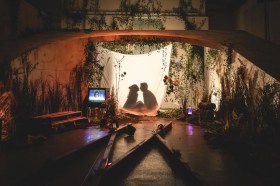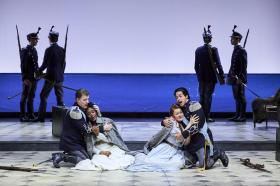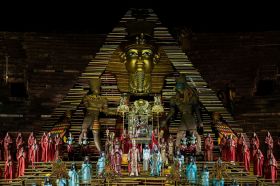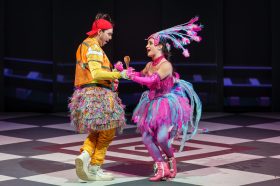O.D.E: quick links
I felt a warm inner glow when I entered The Blue Room Theatre last Friday to see Sage J. Harlow’s experimental chamber opera O,D,E and learned from the program that the initials in the title stand for ‘Orpheus’, ‘Death’ and ‘Eurydice’, a myth that has always been close to my heart.
My soul was further kindled when I sat down in the front row and was greeted by the sight of the six instrumentalists sitting motionless on the floor against the back wall between the Theatre Space and the Mural Room with their eyes closed in an attitude of meditation, while two of the vocalists sat on the floor downstage in a similarly motionless and meditative posture, all softly illuminated by beeswax candles and the lambent glow of traditional halogen theatre lights (not an LED in sight).
O,D,E: open score
O,D,E has an ‘open’ score, meaning that it consists of a series of loosely prescriptive written instructions for an unspecified ensemble of instrumentalists to respond to using improvisation. In this case, the ensemble comprised a zither and electronics player (Eduardo Cossio), saxophone player (Naoko Uemoto), flautist (Saskia Willinge), percussionist (Jane Stark), trumpet and bass player (Craig Pedersen), and laptop ‘player’ (Michael Terren, who was presumably ‘playing’ pre-recorded tracks and perhaps also doing some sound mixing).
The libretto is also by the composer and written in English, such that it forms a continuum with the text of the score and stage directions, almost like the text of a play or screenplay. However, the singers are instructed to respond to it by improvising not only the notes but also the phonemes or sounds of the words themselves.
The result is a structured yet improvised vocal and instrumental sound-continuum which is all the more emotionally immediate because of its singularity and evanescence.
O,D,E: Ancient Greek inspiration
This sense of immediacy is heightened by the mythological and archetypally familiar contours of the story and characters. As mentioned, O,D,E is based on the Ancient Greek story of Orpheus and Eurydice; yet even here the score and libretto permit a series of ‘open’ musical and dramatic variations, inventions and inversions on a set of given mythological as well as musicological themes.
For here it is ‘E’ (Eurydice) who takes on the traditional characteristics of Orpheus (namely his prowess with music and its ‘magickal’ capacity to charm and transform); while ‘O’ on the other hand resembles the original Eurydice in her attitude of surrender to the dictates of death, fate or the Gods.
There are however two more characters who appear through the twin doorways to the Mural Room in the course of the opera. These two additional characters are ‘D’ (who appears as Death but also transcends this role to become the latter’s underlying Self or soul) and ‘O2’, who represents the re-born Eurydice, but who inhabits another body when she returns from the underworld.
Suggestively penumbral lighting and minimal or non-existent set or props illuminate, frame and equip the gorgeously costumed performers, whose outfits are appropriately arcane, restrained and camp in equal measure.
O,D,E: performances
However, ultimate praise is due to the performers themselves, including the finely judged and consummately executed work of the musicians, and the transcendent expressiveness of the singing, acting, movement and gestures on the part of the vocalists – soprano Charis Postmus (‘E’), Tiffany Ha (‘O’), Michael Banting (‘D’) and Lara Dorling (‘O2’) – each of whom has their own distinctive vocal and physical performance style.
Plaudits are also due to co-directors Harper Nguyen and Liam Longley, dramaturg Jeremy Niedeck, and producer Josten Myburg at Tone List, which for some years now has played a vital role in Perth’s artistic and cultural ecosystem, especially in the field of exploratory and experimental music.
In short: this is the kind of local independent work that state opera companies and festivals should have on their radar and be diverting resources to programming, developing and remounting. Meanwhile, the Blue Room website informs me that the rest of the season is sold out.
Get on the waitlist and see it if you can.






